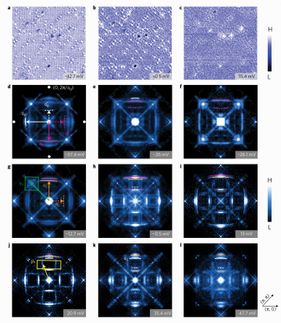Hot Attraction in Bimetals
A cyano-bridged vanadium–niobium bimetal assembly with a Curie temperature of 210 K
Advertisement
Cyano-bridged bimetal assemblies attract attention because of their magnetic properties such as photomagnetization, humidity-induced magnetization, and nonlinear magneto-optical effect, which make them suitable for many applications. A high Curie temperature is an asset for the use of such magnetic compounds in functional materials. Hexa-, hepta-, and octacyanometalates have been shown to have high Curie temperatures as a result of the high coordination number of their metal centers and the large superexchange interactions due to their diffuse 4d or 5d orbitals. Shin-ichi Ohkoshi and his co-workers at the University of Tokyo report the compound with the highest Curie temperature among octacyano-bridged bimetal assemblies in the Short Communication published in the European Journal of Inorganic Chemistry.
On the basis of initial studies indicating that an increased stoichiometry of vanadium(II) led to a higher Curie temperature in vanadium hexacyanochromate systems, Ohkoshi et al. used a small amount of VIII as catalyst to convert a higher proportion of VII in a similar system. The magnetic properties of the resulting octacyano-bridged vanadium–niobium bimetal assembly were investigated. The compound, whose formula was determined to be K0.59VII1.59VIII0.41[NbIV(CN)8] ·(SO4)0.50·6.9H2O, is ferrimagnetic, and the spins on VII and VIII are antiparallel with respect to the spin on NbIV. Its Curie temperature is 210 K. This high value is a result of the enhanced superexchange interaction through the VII–NC–NbIV pathway.
This study reports a strategy to synthesize magnetic materials with high Curie temperature to enhance the suitability of their magnetic properties for applications.
Original publication
Most read news
Original publication
Shin-ichi Ohkoshi et al.; "A Cyano-Bridged Vanadium–Niobium Bimetal Assembly Exhibiting a High Curie Temperature of 210 ."; European Journal of Inorganic Chemistry.
Organizations
Other news from the department science

Get the chemical industry in your inbox
By submitting this form you agree that LUMITOS AG will send you the newsletter(s) selected above by email. Your data will not be passed on to third parties. Your data will be stored and processed in accordance with our data protection regulations. LUMITOS may contact you by email for the purpose of advertising or market and opinion surveys. You can revoke your consent at any time without giving reasons to LUMITOS AG, Ernst-Augustin-Str. 2, 12489 Berlin, Germany or by e-mail at revoke@lumitos.com with effect for the future. In addition, each email contains a link to unsubscribe from the corresponding newsletter.






























































